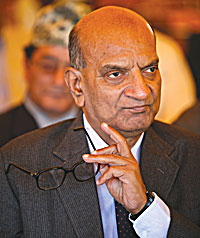 KIRAN PANDAY |
Energised by the legitimacy of the 1980 plebiscite on the monarchy, the Panchayat system appeared unassailable. Through the third amendment to the constitution granted by his father, King Birendra marginally loosened control over political activity. The dreaded Back to the Village National Committee was replaced with a technocratic Panchayat Policy and Evaluation Committee.
The 1982 Rastriya Panchayat elections proved that it was possible to be a communist and a Pancha at the same time, but a kangresi had to renounce his faith to be admitted into the political mainstream run by the royal-military elite.
BP Koirala was such an important figure that when he died in 1983 there was nobody in the party to replace him. The troika of Ganeshman Singh, Krishna Prasad Bhattarai and Girija Prasad Koirala tried, but this was a prescription for factionalism Political confusion had created conditions for the criminalisation of the administration, royal princes dealt openly in contraband, ministers sheltered criminals and police officers looked the other way as organised crime began to use Kathmandu as a safe haven.
This was the roaring eighties, and it was possible to breakfast with Afghan fighters in Jhonchhe, lunch with a Khalistan activist at Durbar Marg and dine with Tamil dissidents in Putali Sadak. Fugitives from all over South Asia used Kathmandu for R&R.
The military was the mainstay of the monarchy, but as king Tribhuban had correctly intuited, the NC was its political insurance policy. Unlike the presidential form of government favoured by the communists, kangresis were wedded to the Westminster model with monarchy. Yet, every king since Mahendra did more to weaken the NC than devise ways of countering leftwing extremism.
In 1985, the NC had initiated the Satyagraha movement to check the influence of Jhapali Naxalites. Marxists like Tulsi Lal Amatya and Man Mohan Adhikari were backing the NC's civic disobedience movement. Alarmed by this, the government used the bombs as an excuse to crack down.
Even though Ram Raja Prasad Singh of the Nepal Janabadi Morcha (and current Maoist presidential candidate) owned up to the terrorist attacks, thousands of NC activists were rounded up all over the country. The few that had remained free during the movement were arrested immediately after the blasts.
The Maoist insurgency since 1996 has inured Nepalis to news of violence, terrorism and disappearances. After the suffering of survivors in Jogimara, and the tragedy of the Madi bus bomb, reports of civilian casualties have ceased to shock the nation's conscience. But the 1985 bombs established the efficacy of terrorism and exposed the weaknesses of an autocratic regime demoralised by self-doubt, internal dissent and lack of electoral legitimacy.
Disappearances first appeared in the police lexicon. Laxmi Narayan Jha, Iswar Lama, Padam Lama, Maheswar Chaulagain and Saket Mishra were disappeared while in police custody. Years later, when we approached Prime Minister K P Bhattarai to trace them, his laconic answer was: "They may have been killed". Jha was a renowned physician and the Nepal Medical Association unsuccessfully pursued his case until the mid-nineties.
Thousands have been missing since the Maoist insurgency began. We have a comprehensive peace process, but the question of people who disappeared in captivity remains unresolved-from this war and from previous regimes.
We must start from the beginning. Today, 23 years after they were picked up at random, the families of the disappeared of 1985 deserve an answer from the first republican government of the country.



